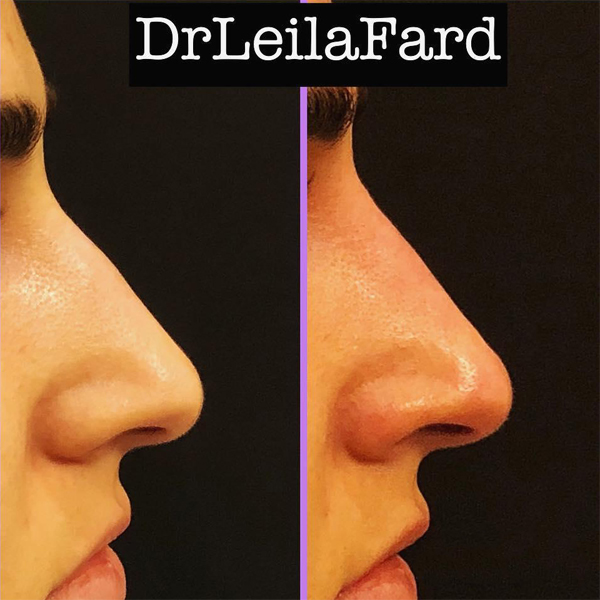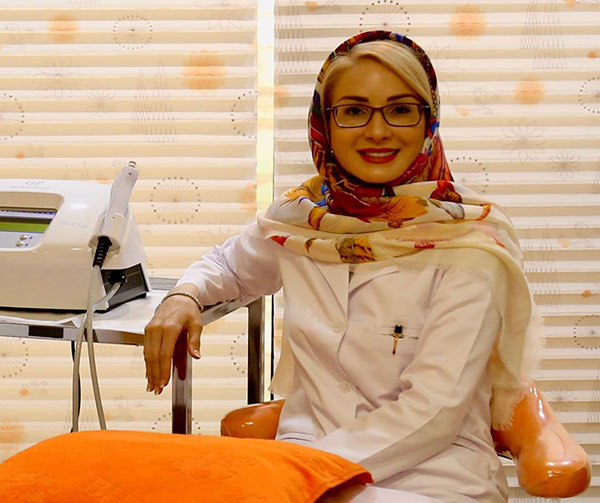Discontented with the look of your nose, but hesitant about undergoing surgery? It’s time to get familiar with the latest method of correcting nasal deformities, designated as soft rhinoplasty. Soft rhinoplasty or nasal form correction with filler injection is one of the latest techniques to correct the nose shape without surgery or anesthesia at all. Follow the words of Dr. Leila Fard to get thoroughly informed about the details of this treatment method.
What is soft rhinoplasty?
Soft rhinoplasty, or non-surgical rhinoplasty, is an outstanding way to correct septal defects and supratip deformities. This method is suitable for those who do not want to undergo rhinoplasty or have a minor deformity or defects following prior surgery. These minor deformities and defects can be corrected without anesthesia and surgery by filler injection.

Dr. Leila Fard:
Soft rhinoplasty denotes filling the nose deformity with a filler or hyaluronic gel. Soft rhinoplasty can partially correct nasal deformities with filler and Botox by soft rhinoplasty. Nasal prolapse is corrected by about 20 to 30% with Botox injections. The deformities seen in the nasal septum and supratip can be likewise partially corrected by delicately injecting a specific and estimated amount of gel or filler. Please note that the soft rhinoplasty method is not suitable for everyone, and some types of deformities require surgery.
How to determine the appropriateness of the nose type for correction with filler?
The nasal area is one of the most vascular areas of the face. The nose is deemed one of the most sensitive areas for filler injection due to the proximity and presence of an abundant number of delicate and vital vessels. Therefore, the doctor who oversees the nasal filler injection procedure should be experienced and competent with a mastery of face anatomy at the same time.
Dr. Leila Fard:
You should visit and undergo an examination from different angles to determine if a nasal filler procedure is right for you or not. Accordingly, it is significant to check your cartilage and bone tissue while examining the shape and condition of your soft tissue.
When there is an issue with any of the nose components, including soft tissue, bone, or cartilage, deformity or defects occur. Some of these deformities can be corrected by filler injection.
Can wide and fleshy noses be corrected with filler injections?
Wide and fleshy noses usually cannot be corrected with a filler or hyaluronic injections. It is only conceivable to correct their septum issues through minor filler injections. Fleshy noses are advised to undergo rhinoplasty surgery for any nose from correction.
The best fillers for nasal injections
High-quality and delicate fillers, such as those listed below, must be employed for soft rhinoplasty procedures.
• Stylage S
• Belotero Balance
• Juvederm volbella
Which nasal issues can be corrected by filler injection?
Soft rhinoplasty with filler is a new non-surgical method for correcting minor nasal defects, such as:
• Some types of nasal vascular deformities that develop without surgery or post-surgery
• Septum issues that develop without surgery or post-surgery
• Supratip deformities
How long does the nasal filler effect last?
The longevity of the nasal filler is approximately 1.5 to two years since the nose does not show much muscle movement. In some cases, Botox can help with a sagging supratip nose. The longevity of the Botox procedure is approximately three months.
Note that the nose reverts to its original state when your filter is no longer.
Does soft rhinoplasty procedure hurt?
An anesthetic cream is applied thoroughly over the nose, and the injection is performed under the influence of anesthesia. If we rate severe and unbearable pain within the range of zero to ten, the pain felt during nasal filler injection is a number between two to three.
Examples of nasal filler injections in Dr. Leila Fard’s clients

In these clients, who were dissatisfied by the sagging of the nose tip (supratip) and the unevenness of the septum area in the profile, remarkable changes were made in the nose within a few minutes by injecting a filler after half an hour of anesthesia obtained under the influence Emla cream. These changes last about one year to one year and a half.

This client had been suffering from prolapsed nostrils resulting from an ineffective rhinoplasty procedure. I corrected the septum area with style S filler as much possible as the nose texture allowed.

In this case, anesthesia was not suitable due to the client’s heart issues. A filler injection in the septum area and the correction of the sagging nose supratip changed the situation for the better.

For this client, I employed a Stylage filler to correct the sagging supratip tip of the nose. I also injected Botox to the nose tip, which would render results within the next three to five days and lifts the nose tip.





